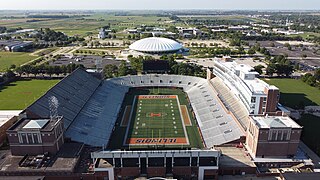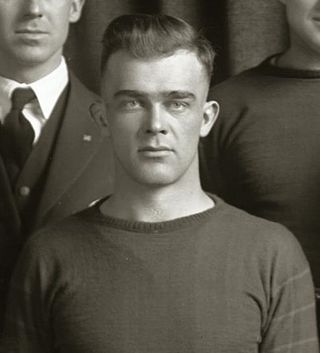The Red Menace is the name of the bleacher section behind the North end zone in University Stadium, the home field of the New Mexico Lobos. It is known for having some of the most-rabid fans in the Mountain West Conference.
The Red Menace is the name of the bleacher section behind the North end zone in University Stadium, the home field of the New Mexico Lobos. It is known for having some of the most-rabid fans in the Mountain West Conference.
Following the expansion and renovation of the north end of the stadium in 2001, which included a new bleacher section around the north end zone that held 5,700 additional fans. The idea was to establish a fanatical tradition at University Stadium. The idea of a group of fans sitting in that section, patterning it after the Cleveland Browns’ “Dawg Pound,” originated on Cherrysilver.com, a Web site for UNM athletics fans. The response was immediate, and soon, “The Red Menace” numbered in the hundreds. Lee Roy Lucero and fellow Cherrysilver.com operator Dom Zarella began working with the athletics department to sell tickets for the group at a discounted rate and they advertised it on their Web site.
After year three TheRedMenace.com started attending Lobo football practices and writing daily reports becoming the first media outlet in the state of New Mexico to take such an active interest in UNM football. Since that time TRM as it is affectionately known has published thousands of practice, game, and recruiting reports interviewing thousands of players.
Red Menace fans carry a notorious reputation for their fondness of face-painting, colorful attire, and barking like a dog for approximately three straight hours. In addition, University of New Mexico football players participate in the famous “Lobo Leap”, where the players leap and celebrate with the fans following every game.
TheRedMenace.com is celebrating their 15th year in existence with Lee Roy Lucero still at the helm. His writers include Wes Henderson and Rudy Chavez.

The University of New Mexico is a public research university in Albuquerque, New Mexico. Founded in 1889 by the New Mexico Territorial Legislature, the University of New Mexico (UNM) is the state's second oldest university, the flagship university of the state, and the largest by enrollment, with approximately 23,000 students in 2023.

Memorial Stadium is a stadium on the campus of the University of Illinois Urbana-Champaign in Champaign, Illinois, United States. The stadium, used primarily for football, is a memorial to the university's students who died in World War I; their names are engraved on the nearly 200 pillars surrounding the stadium's façade. With a capacity of 60,670, the stadium is primarily used as the home of the university's Fighting Illini football team.

Fred C. Yager Stadium is a football stadium in Oxford, Ohio, United States. It is home to the Miami University RedHawks football team. It has a capacity of 24,286 spectators, and was built in 1983. It replaced Miami Field, which had been used since 1895 and was the home field for many of the coaches who had made the school famous. The stadium is named for Fred C. Yager, class of 1914, who was the lead benefactor in the project to build the stadium.

Bill Snyder Family Stadium is a stadium in Manhattan, Kansas. It is used for American football, and is the home field of the Kansas State University Wildcats football team. It is named after the family of head coach Bill Snyder. Over the past 31 seasons – from 1990 through the 2022 season – K-State is 169–51–1 (.767) at home.

Dix Stadium is a stadium in Kent, Ohio, United States. It is primarily used for American football, and is the home field of the Kent State Golden Flashes football team. In addition, since 2016 the stadium is also home to the Kent State women's soccer team and since 2019 to the women's lacrosse team. Previously, it was home to the Kent State field hockey team from 1997 to 2004 and served as a secondary home for the KSU men's soccer team in the 1970s. It opened on September 13, 1969 and was named in 1973 after Robert C. Dix, former publisher of the Record-Courier and a member of Kent State's Board of Trustees for more than three decades. It was built as an expansion and relocation of Memorial Stadium, with all of Memorial Stadium's main seating areas used at the current stadium in a new configuration. During soccer games, the playing surface is known as Zoeller Field.

University Stadium is an outdoor football stadium in the western United States, located on the south campus of the University of New Mexico in Albuquerque, New Mexico. It is the home field of New Mexico Lobos football, which competes as a member of the Mountain West Conference.
The New Mexico Lobos men's basketball team represents the University of New Mexico, competing in the Mountain West Conference (MWC) in NCAA Division I. The university established basketball as a varsity sport in 1899 and began competing with regional colleges after establishing an athletics department in 1920.

Peden Stadium, also known as Frank Solich Field at Peden Stadium since August 2022, is an American football stadium on the campus of Ohio University in Athens, Ohio. Situated on the banks of the Hocking River with a seated capacity of 24,000, Peden Stadium has been the home of the Ohio Bobcats Football team since 1929. An example of early 20th Century sports venues, it is the oldest college football venue in the Mid-American Conference, the third oldest in Ohio, and the 29th oldest college stadium in the nation.

The New Mexico Lobos football team is the intercollegiate football team at the University of New Mexico. The Lobos compete as a member of the Mountain West Conference. Their official colors are cherry and silver. The Lobos play their home games at University Stadium.

Lubbers Stadium, or Arend D. Lubbers Stadium, is a stadium on the Grand Valley State University's main campus in Allendale, Michigan, USA. The stadium was named after former university president Arend Lubbers. It is primarily used for American football, and is the home field of the Grand Valley State Lakers. "Lakers Stadium" - as it was originally known - was constructed in 1972, and opened in 1973. It now officially seats 10,444 people - though it almost always holds thousands more fans. The stadium is also home to a football offices and weight training facility.

The New Mexico Lobos are the athletic teams that represent the University of New Mexico, located in Albuquerque. The university participates in the NCAA Division I in the Mountain West Conference (MW) since 1999, after leaving the Western Athletic Conference. The university's athletic program fields teams in 16 varsity sports.

The Rio Grande Rivalry is the name given to the New Mexico–New Mexico State football rivalry and known as the Battle of I-25. It is an intercollegiate rivalry between The University of New Mexico and New Mexico State University. The rivalry began in 1894. In comparison, New Mexico was a United States Territory from September 1850 to January 1912, when it became a member of the United States and the Union.

Ira Lee Harge is a retired American professional basketball player. Born in Anguilla, Mississippi, Harge played high school basketball in Detroit, Michigan before starring in college at the University of New Mexico. He played professionally in the American Basketball Association for six seasons, playing on two ABA championship teams. Harge earned a master's degree in education from UNM in 1969 and became a coach and teacher in Albuquerque after his playing career ended.

The 2010 Texas Tech Red Raiders football team represented Texas Tech University as a member of the Big 12 Conference during the 2010 NCAA Division I FBS football season. Led by first-year head coach Tommy Tuberville, the Red Raiders compiled and overall record of 8–5 with a mark of 3–5 in conference play, placing fifth in the Big 12's South Division. Texas Tech was invited to the inaugural TicketCity Bowl, where they defeated Northwestern, 45–38. The team played home games at Jones AT&T Stadium in Lubbock, Texas

The Lobo is the official mascot of the University of New Mexico (UNM). Lobo Louie and Lobo Lucy are costumed wolf mascots, members of the UNM cheerleading squad, who rouse and entertain fans during Lobo athletic events.
The 2013 New Mexico Lobos football team represented the University of New Mexico in the 2013 NCAA Division I FBS football season. The Lobos were led by second-year head coach Bob Davie. They played their home games at University Stadium and were members of the Mountain Division of the Mountain West Conference. They finished the season 3–9, 1–7 in Mountain West play to finish in sixth place in the Mountain Division.

Roy William Johnson, nicknamed "Old Ironhead," was an American football player, coach of football, basketball, and baseball, and college athletics administrator. He served in various capacities in the athletics program at the University of New Mexico for nearly 40 years. He was the university's athletic director from 1920 to 1949, head football coach from 1920 to 1930, and head basketball coach from 1920 to 1931 and 1933 to 1940. He also coached New Mexico's track and tennis teams. In 1957, the university named the newly built Johnson Gymnasium in his honor.

The Pit is an indoor arena in Albuquerque, New Mexico, serving primarily as the home venue of the University of New Mexico Lobos basketball teams. The facility opened in 1966 as University Arena but gained the nickname "The Pit" due to its innovative subterranean design, with its playing floor 37 feet (11 m) below street level. The arena is located on the UNM South Campus and has a seating capacity of 15,411 for basketball and up to 13,480 for concerts, with 40 luxury suites and 365 club seats.
The 1983 New Mexico Lobos football team was an American football team that represented the University of New Mexico in the Western Athletic Conference (WAC) during the 1983 NCAA Division I-A football season. In their first season under head coach Joe Lee Dunn, the Lobos compiled a 6–6 record and outscored opponents by a total of 239 to 233.
The University of South Florida athletic facilities are the stadiums and arenas the South Florida Bulls use for their home games and training. The University of South Florida currently sponsors 19 varsity athletic teams and has 11 facilities in the designated Athletics District on or adjacent to its Tampa campus, one on its St. Petersburg campus, and one elsewhere in Tampa. 18 of the 19 teams have some sort of facility in the USF Athletics District.